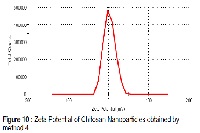Optimization and effects of physico-chemical parameters on synthesis of chitosan nanoparticles by ionic gelation technique
Keywords:
Chitosan, Poly Vinyl alcohol, Ionic Gelation technique, polydispersity indexAbstract
Biopolymers are used as vehicles for the carrying drugs to their site of action. These polymers are less toxic and can even protect the drug entity from degradation in physiological conditions of the body. Large number of techniques are employed to prepare the nanoformulation of these polymers but ionic gelation is of great interest because no harsh and incompatible chemicals are used during the process. Chitosan nanoparticles are good drug carriers because of their good biocompatibility and biodegradability. As a new drug delivery system they have attracted attention due to their applications in loading protein, drugs etc. In the present research ionic gelation technique have been optimized for the preparation of chitosan nanoparticles. Various physico-chemical parameters of Nanoparticles such as size, Zeta potential and poly dispersity index were evaluated under different process parameters. In current study onic gelation technique had been optimized for the preparation of chitosan nanoparticles. We have evaluated the effect of various physico-chemical parameters such as type of polyanion, Sonication, surfactant etc and their effect on size and zeta potential of nanoparticles had been studied. A novel Nanoparticle system composed of low molecular weight chitosan was successfully prepared in the present study by simple ionic-gelation techniques under aqueous-based conditions. It was observed that there was considerable effect of various physico- chemical parameters on size, zeta potential and polydispersity index of Nanoparticles prepared. Result shows that the size of Nanoparticles decreases with the increase in concentration of Chitosan. Polyvinyl alcohol was found to be the best surfactant because it was very effective in decreasing the surface tension without increasing viscosity. Intermittent sonication during the process decreases the size of Nanoparticles considerably. Controlled use of polyanions under different conditions can develop negatively charged Nanoparticles that can be used for delivery of positively charged drugs and therapeutic molecules.
References
Sahoo SK, Labhasetwar:Nanotech approaches to drug delivery and imaging.Drug Discov Today.2003;8(24): 1112-1120
Frokjaer S, Otzen DE :Protein drug stability: a formulation challenge. Nature Rev Drug Discov.2005; 4: 298–306
Wilding IW, Davis SS, O’hagen DT: Targeting of Drugs and vaccines to the gut. Pharmacol. Ther.1994;62:97-124
Sakuma S, Hayashi M, Akashi M ( 2001) Design of nanoparticles composed of graft copolymers for oral peptide delivery. Adv Drug Deliv Rev 47: 21–37
Meclean S, Processer E, O'Malley D, Clark N, Ramtoola Z, Brayden D. Binding and uptake of biodegradable polylactide micro and nanoparticles in intestinal epithelia. Eur J Pharm Sci 6: 153-63
Agnihotri SA, Mallikarjuna NN, Aminabhavi TM (2004) Recent advances on chitosan based micro and nano particles in drug delivery. J Control rel 100:5-28
Loftssora, T (1998) Cyclodexterins in opthalermic drug delivery. Adv Drug Deliv Rev 36: 59-79
Cherian AK, Rana AC, Jain SK (2000) Self assembled carbohydrates stabilized nanoparticles for the potential delivery of drug delivery. Ind Pharm 26: 459-63
Sarkar DK (2005) Engineering of nanoemulsions for drug delivery. Curr Drug Deliv 2:297-310
Wang L, Wang A: J Hazard Mater.2006; 136:930.
Hirsch IR, Gobin A.M, Lowery AR, Tom F, Drezek RA, Halas NJ: Metal nanoshells. Ann biomed Engg. 2006; 34: 15-22
Bermudez E, Mangum JB , Wong BA Asgharian B, Hext PM, Waheit DB, Everitt JI : Pulmonary responses of mice, rats and hamsters to subchronic inhalation of ultrafine titanium dioxide particles. Toxicol Sci.2004;77:347-357
Warheit DB, Webb TR, Sayes CM, Colvin VL, Reed KL: Pulmunary instillation studies with nanoscale TiO2 rods and dots in rats: Toxicity os not dependent on particle size ans surface area. Toxol Sci. 2006; 91:227-236
Takenaka S, Karg E, Kreyling W, Lentner B, Schulz H, Ziesenis A, Schramel P, Heyder , J: Fate and toxic effects of inhaled ultrafine cadmium oxide particles in the rat lung. Inhalation Toxicol. 2004; 16:83-92
Serita F, Kyono H, Seki Y: Pulmonary clearance and lesions in rats after a single inhalation of ultrafine metallic nickel at dose levels comparable to the threshold limit value. Ind. Health. 1999, 37:353-363
Hussain SM , Hess KL, Gearhart JM, Geiss KT Schlager JJ: In vitro toxicity of Nnanoparticles in BRL 3A rat liver cells. Toxicol In Vitro. 2005; 19: 975-983
Kawanaka , Matsumoto E, Wang N, Tsuchiya Y, Yun SJ, Jiang ZW, Sakamoto K: Mutagenic activity of atmospheric ultrafine particles at a roadside site and a suburban site. J. Health Sci. 2006, 52:352-357
Calvo P, Remunan-Lopez C, Vila-Jato JL, Alonso MJ: Novel hydrophilic chitosan-polyethylene oxide nanoprticles as protein carriers. J. Appl. Polymer Sci. 1997, 63: 125-132
Wang JJ, Zeng ZW, Xiao RZ, Xie Tian, Zhou GL. Zhan XR, Wang SL Recent advances of chitosan nanoparticles as drug carriers. International J. of nanomed. 2011, 6: 765-774
Thanou M, Verhoef JC, Junginger HE: Oral drug absorption enhancement by chitosan and its derivatives. Adv. Drug Deliv. Rev. 2001; 52, 117–126.
Bhatia A, Shard P, Chopra D, Mishra T : Chitosan nanoparticles as Carrier of Immunorestoratory plant extract: synthesis, characterization and Immunorestoratory efficacy.Int. J. of Drug Del. 2011; 3:381-385
Kowapradit J,Opansopit P, Ngawhirunpat T, Apirakaramwong A, Rojanarata T, Ruktanonchai U, Sajomsang W: Invitro permeability enhancement in intestinal epithelial cells(caco-2)monolayer of water soluble quaternary ammonium chitosan derivatives.AAPS Pharm Sci Tech.2010;11(2):497-508
Zhang HL,Wu SH, Tao Y, Zang LQ, and Su ZQ:Preparation and characterization of water soluble chitosan nanoparticles as protein delivery system.J. of Nanomaterials, 2010; 2010: 898910
Gan, Q., Wang, T.,Cochrane, C.,McCarron, P: Modulation of surface charge, particle size and morphological properties of chitosan-TPP nanoparticles intended for gene delivery. Colloids and Surfaces B: Biointerface. 2005; 44, 65-73.
Vila A, Sanchez A, Janes K, Behrens I, Kissel T,Jato JLV and Alonso MJ : Low molecular weight chitosan nanoparticles as new carriers for nasal vaccine delivery in mice. European J. of Pharma and Biopharma. 2004;57, 123-131.
Adams DJ, Morgan LR: tumor physiology and charge dynamics of anti cancer drugs: Implications for Camptothecin based drug development.Curr Med Chem. 2011;18(9):1367-1372
Janes KA , Calvo P, Alonso MJ: Polysaccharide colloidal particles as delivery systems for macromolecules. Adv. Drug Deliv. Rev. 2001, 47: 83–97






